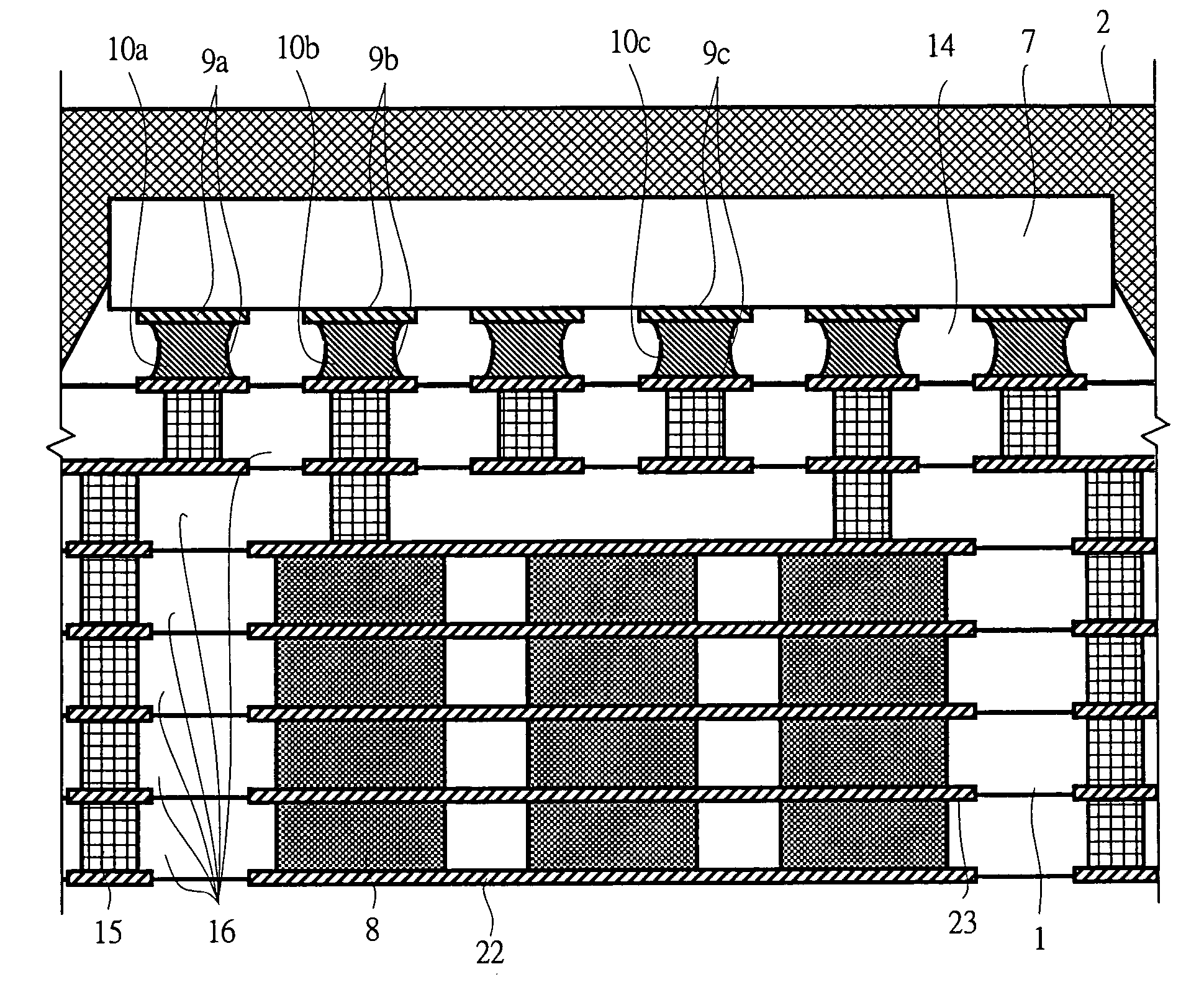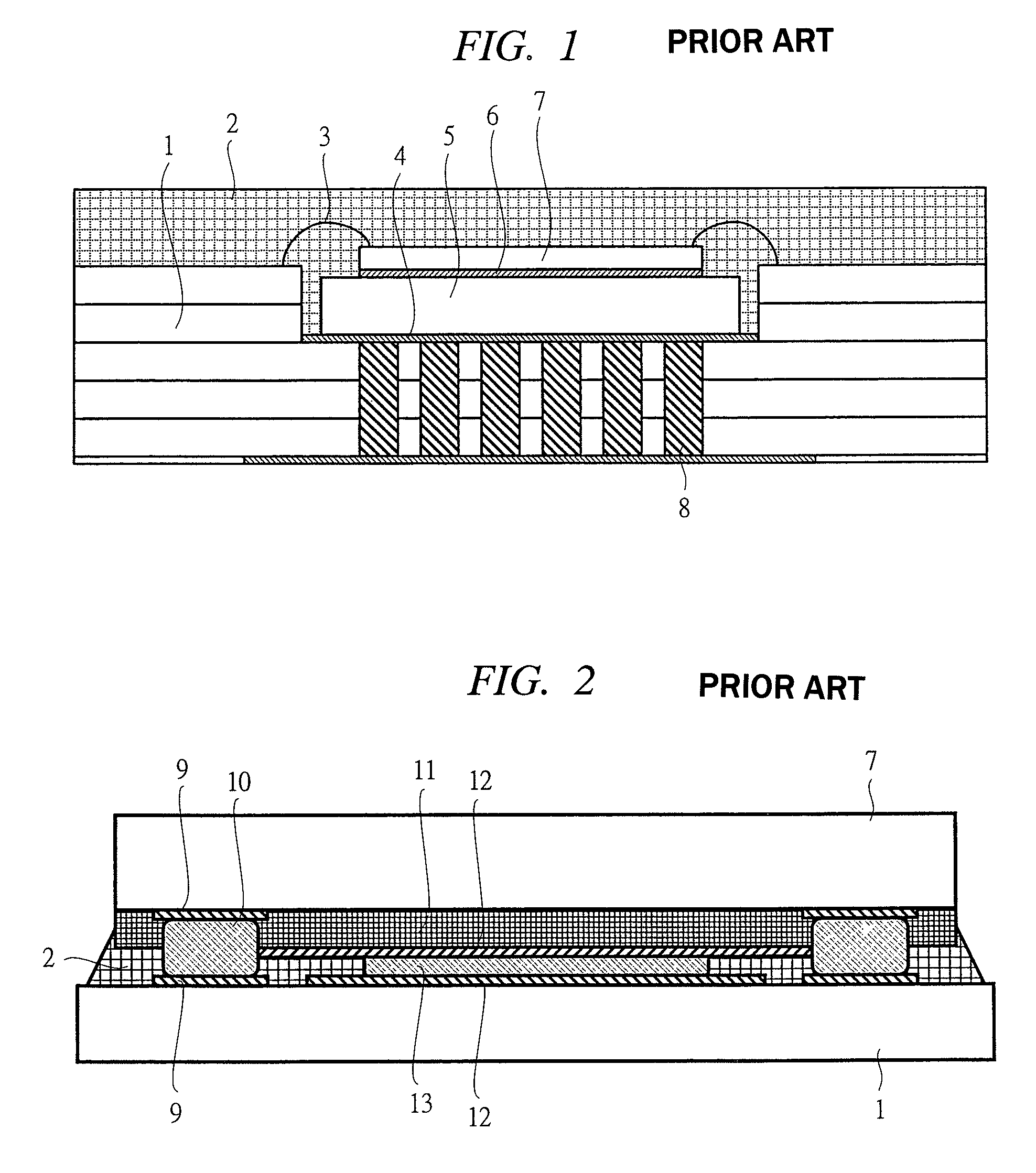Semiconductor device
a technology of semiconductor devices and semiconductors, applied in semiconductor devices, semiconductor/solid-state device details, electrical equipment, etc., can solve the problems of increased product cost, limited thermal resistance reducing effect, complicated and expensive packaging process, etc., to improve radiation performance and mass productivity.
- Summary
- Abstract
- Description
- Claims
- Application Information
AI Technical Summary
Benefits of technology
Problems solved by technology
Method used
Image
Examples
first embodiment
[0043]A semiconductor device according to the present invention will be described with reference to FIG. 3 to FIG. 9. FIG. 3 is a cross-sectional view showing a packaging structure of a semiconductor device. FIG. 4 is a diagram showing the layout of element bump electrodes in the semiconductor device. FIG. 5 is a cross-sectional view showing a connection structure from an active area to a circuit board in the semiconductor device. FIG. 6 is a cross-sectional view showing a packaging structure of the semiconductor device in which thermal vias are formed in the second and lower layers of the circuit board. FIG. 7 is a cross-sectional view showing another connection structure from an active area to a circuit board in the semiconductor device. FIG. 8 is a cross-sectional view showing still another connection structure from an active area to a circuit board in the semiconductor device. FIG. 9 is a cross-sectional view showing a connection structure from an active area to a thermal via in...
second embodiment
[0054]A semiconductor device according to the second embodiment of the present invention will be described with reference to FIG. 10 to FIG. 13. FIG. 10 is a diagram showing an example where source electrodes are closely aligned in the layout of the element bump electrodes in the semiconductor device. FIG. 11 is a cross-sectional view showing the connection structure from an active area to a thermal via in the wiring layers on the source or emitter side in the semiconductor device. FIG. 12 is a cross-sectional view showing another connection structure from an active area to a thermal via in the wiring layers on the source or emitter side in the semiconductor device. FIG. 13 is a cross-sectional view showing still another connection structure from an active area to a thermal via in the wiring layers on the source or emitter side in the semiconductor device. Note that the cross-sectional structures of the semiconductor device of this embodiment which do not overlap with FIG. 10 to FIG...
third embodiment
[0059]A semiconductor device according to the third embodiment of the present invention will be described with reference to FIG. 14 to FIG. 18. FIG. 14 is a diagram showing an example where source electrodes are united to form a strip-shaped electrode in the layout of the element bump electrodes in a semiconductor device. FIG. 15 is a cross-sectional view showing a connection structure from an active area to a thermal via in the wiring layers on the source or emitter side in the semiconductor device. FIG. 16 is a cross-sectional view showing another connection structure from an active area to a thermal via in the wiring layers on the source or emitter side in the semiconductor device. FIG. 17 is a cross-sectional view showing still another connection structure from an active area to a thermal via in the wiring layers on the source or emitter side in the semiconductor device. FIG. 18 is a perspective view showing the positional relation between the bump electrode and the active area ...
PUM
 Login to View More
Login to View More Abstract
Description
Claims
Application Information
 Login to View More
Login to View More - R&D
- Intellectual Property
- Life Sciences
- Materials
- Tech Scout
- Unparalleled Data Quality
- Higher Quality Content
- 60% Fewer Hallucinations
Browse by: Latest US Patents, China's latest patents, Technical Efficacy Thesaurus, Application Domain, Technology Topic, Popular Technical Reports.
© 2025 PatSnap. All rights reserved.Legal|Privacy policy|Modern Slavery Act Transparency Statement|Sitemap|About US| Contact US: help@patsnap.com



